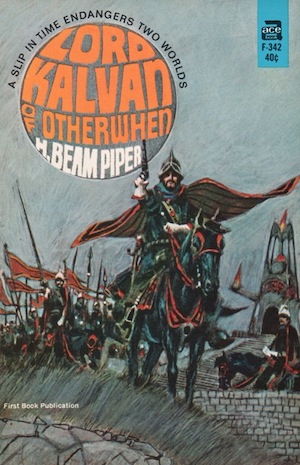My Because My Tears Are Delicious To You project recently reached a milestone: 500 reviews of works I read as a teenager. By chance, but very appropriately, the 500th book was one by Ron Goulart, a man whose career was a tribute to what you can accomplish with steady productivity carried out over decades. All it took to get me to Tears Review #500 was one review a week since 2014. I did it and you could do it too!
Rereading once treasured books half a century later is not without risk, for reasons explained in this venerable Jo Walton essay. Thus, the name of that particular set of reviews. Nevertheless, the project hasn’t been all regrettable politics, egregious sexism, courageous grooming choices, and cover art I can’t share here without risking an NC-17 rating. In fact, there are any number1 of olden-time books I enjoyed revisiting. Here are ten.
That number could have been much larger.2 But this is all the news that fits. If you’ve read any of these books, congrats! I hope you enjoyed them and that this review has revived pleasant memories. If some are new to you, perhaps you’ll consider adding them to your TBR pile, otherwise known as Mount Tsundoku…
Lord Kalvan of Otherwhen by H. Beam Piper (1965)

A paratime mishap catapults Pennsylvania cop Calvin Morrison from the USA he knows into an alternate North America on the brink of war. The greedy priests of Styphon are determined to commandeer some sulfur springs owned by the kingdom of Hostigos. Hostigos is uncooperative and it has been targeted for conquest. Calvin has just the right set of skills to save the kingdom. Too bad that Calvin’s introduction to the kingdom (and its ruler, Princess Rylla) was being shot in the chest by the princess.
This is a feel-good wish-fulfilment adventure about an underappreciated man who flourishes in a new environment. Otherwhen is also the rare 1960s SF novel in which the women get to do stuff that matters.
The Reproductive System by John Sladek (1968)

Eager to get that sweet, sweet military-industrial complex moolah, the venerable Wompler doll company retools itself for war. The only minor sticking point is that the Womplers not only lack the necessary expertise, they do not understand that they lack the necessary expertise. Thus, MIT grad Cal is hired. He’s in way over his head, because the MIT from which he graduated was the Miami Institute of Technocracy. The Womplers also hire the mysterious Dr. Smilax. The good doctor just happens to be a mad genius. Soon the world will cower before Smilax.
This is a satire in which appalling childhoods have left virtually everyone incompetent or utterly deranged, where even the sympathetic characters lean towards nincompoopery. Yet somehow, the novel never descends into nihilism. One wants the protagonists to prevail, or at least survive… even if you would not trust them with a plastic spork.
The Continuous Katherine Mortenhoe by D.G. Compton (1974)

Terminal illness has transformed middle-aged Katherine Mortenhoe from an unremarkable nobody to a commodifiable celebrity. In an era in which everyone enjoys perfect health, the bored public will pay good money to watch Mortenhoe sicken and die. Promising reporter Roddie is assigned the task of tailing the dying woman. The public will not be denied their entertainment!
While some of the technical details reflect the era in which it was written, Compton’s tale of inhuman, unethical voyeurism is timeless. Alas.
Analog Science Fiction/Science Fact, June 1977 edited by Ben Bova (1977)

Ben Bova celebrated the soaring numbers of women SF authors with a Special Women’s Issue of Analog—which in 1977 meant that no less than thirteen of the twenty-seven pieces in this issue are by women. Analog is an SF magazine and thus many of the works are echt SF. But this issue also showcased works aren’t the usual Analog fare: deadly aristocratic politics, courtroom drama, even a non-fiction piece about Michael Ovenden and Tom Van Flandern’s non-consensus planetary science.
Two of the stories in this issue—Joan D. Vinge’s “Eyes of Amber” and “The Screwfly Solution” by James Tiptree Jr. (writing as Raccoona Sheldon)—won awards. The other stories are almost as memorable. You could argue that the gender balance in this Special Women’s issue wasn’t quite what you expected (less than half), but if you’re going to hunt down one issue of Analog, this is the issue you should seek out.
Mind of My Mind by Octavia Butler (1977)

Mary is a Campbellian superhuman, the product of generations of directed breeding, possessed of powers beyond mortal ken. The motive behind the lengthy eugenics program is horrific. Body-hopping Doro finds psychic brains delectable and his powers make him impossible to resist. At least, they did until Mary appeared.
The series of which this book is a part is formally titled the Patternist series, after the human culture that arises after Mary institutes certain reforms. It could just as easily be known as “And Then Things Got Much Worse.” Doro is a complete monster, but Mary and her descendants are almost as bad, and much better at multitasking.
Born to Exile by Phyllis Eisenstein (1978)

Alaric the Minstrel has many gifts. His singing voice earns him a living. His ability to teleport would earn him guest of honour status on a flaming pyre, if the superstitious bumpkins around him were to find out (and could catch him). Alaric has always wondered where his gift comes from. Some questions are best left unanswered.
For reasons I cannot fathom, Eisenstein was not one of the beneficiaries of the ebook boom. All of her books appear to be out of print. Quite vexing.3 Nevertheless, this fix-up is worth the effort to find.
Dreamsnake by Vonda N. McIntyre (1978)

Expanding on 1973’s “Of Mist, and Grass, and Sand,” Dreamsnake is the tale of Snake the healer. Snake wanders a desolate Earth, offering its impoverished people precious medical skills. Peasant prejudice costs the healer a precious medical serpent. She might find a replacement at Earth’s last city, Centre. While Centre is known for many things, charity is not one of them.
Dreamsnake shares a setting with McIntyre’s The Exile Waiting and while Dreamsnake can be bleak, it is nowhere as bleak as Exile. One might go so far as to say there are moments of hope. There are also interpersonal relationships that were quite daring in 1978, although I imagine they might seem commonplace to the progressive youth of today.
Eyes of Amber and Other Stories by Joan D. Vinge (1979)

As was the custom in those days, Vinge focused on short stories before moving into novels. In this story, we meet an aristocrat confronting the cost of vengeance, a woman questioning her exile, a journalist dealing with a murder, and more.
This remarkable book came in second for Locus’ Best Single Author Collection. The science fiction stories within it earned numerous award nominations and in the case of the title story, a Hugo win. It’s quite annoying that the collection has been out of print for so long and that no more recent collection has subsumed the stories within it.
The Beehive by Margaret O’Donnell (1980)

Thirty years ago, Gorston liberated his economically troubled nation from the ravages of democracy and freedom. Society is regimented according to Gorston’s narrow views. This is especially true for women, relegated to domesticity or sexless drudgework. Sarah Hillard is determined to deliver revolution…if the secret police do not arrest and execute her first.
This gender dystopia is an oddly obscure classic, having gone out of print after one edition. Pity, because it deserves to be better known than it is. Good news: I’ve heard that a publisher would like to reprint The Beehive, if they can track down its elusive author.
The Best of All Possible Worlds by Spider Robinson (1980)

Jim Baen responded to Spider Robinson’s lament about uncollected classics with an interesting notion. Each author of the stories anthologized by Robinson would suggest another forgotten treasure by another author. The result was a hefty volume filled with a wide range of science fiction and fantasy stories, as well as informative ancillary material.
In addition to a fine selection of stories, this is one of those works whose contributors are so manifestly keen on the project that their enthusiasm is catching. Fun can be contagious and this anthology is proof. It’s clear from comments elsewhere that a second volume was planned. I wonder if the MS survives?
These are just a few of the classics I have enjoyed revisiting. No doubt some of the omissions may baffle and confound a few of you. Feel free to query me about the curious absence of such well-known works such as…well, naming them is really more your task.
- As long as that number is equal to or less than 500. ↩︎
- No mysteries: sorry, Death Comes as the End. No historicals: sorry, The Lantern Bearers. No CanLit: so with enormous regret I must omit Marian Engel’s Bear (go ahead, google that). No non-fiction: so no The Curve of Binding Energy. No RPGs: so no Cults of Prax. Really, there are always far more interesting works than time to discuss them. ↩︎
- Reviewing every Eisenstein book (save for those already reviewed) is on my 2024 to-do list. ↩︎










